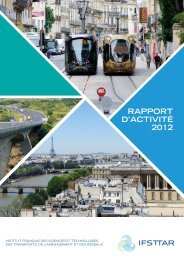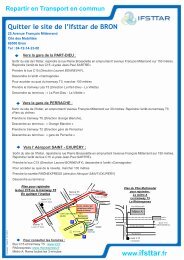french institute of science and technology for transport ... - Ifsttar
french institute of science and technology for transport ... - Ifsttar
french institute of science and technology for transport ... - Ifsttar
Create successful ePaper yourself
Turn your PDF publications into a flip-book with our unique Google optimized e-Paper software.
2_SCIENTIFIC AND TECHNICAL ACTIVITIES<br />
Road traffic management<br />
New techniques<br />
0,8<br />
0,7<br />
0,6<br />
0,5<br />
0,4<br />
0,3<br />
0,2<br />
The requirements <strong>of</strong> sustainable mobility are prompting<br />
road operators to test new road traffic management<br />
techniques. A new multicriteria approach <strong>for</strong> evaluating<br />
these, which is based on the level <strong>of</strong> service, was finalized<br />
in 2011.<br />
During the day, a road operates with four possible levels<br />
<strong>of</strong> service: free flow, dense flow, capacity flow <strong>and</strong> saturated<br />
flow. The level <strong>of</strong> service is linked not only to the physical<br />
characteristics <strong>of</strong> the road <strong>and</strong> traffic dem<strong>and</strong>, but also driving<br />
Mean<br />
Min<br />
Max<br />
behaviours <strong>and</strong> the weather. The level <strong>of</strong> service concept can<br />
be used to evaluate the impact <strong>of</strong> traffic management techniques<br />
on congestion, the environment <strong>and</strong> safety. Variations<br />
in the total time spent driving under saturated conditions characterizes<br />
how a traffic management measure affects congestion.<br />
Aggregating data on the basis <strong>of</strong> level <strong>of</strong> service is a more<br />
precise way <strong>of</strong> computing pollution <strong>and</strong> fuel consumption than<br />
the usual breakdown by mean vehicle speed bracket. Last,<br />
the rate <strong>of</strong> injury accidents on a network is related to the<br />
levels <strong>of</strong> service at the time. The methodology is undergoing<br />
validation <strong>for</strong> a number <strong>of</strong> variable lane allocation operations<br />
(<strong>for</strong> example the taxi lane on the A1 motorway). In addition,<br />
a network operation strategy selection tool, which takes the<br />
<strong>for</strong>m <strong>of</strong> a catalogue <strong>of</strong> st<strong>and</strong>ard cases, is being developed. It<br />
can be used <strong>for</strong> the Paris region network to make decisions<br />
on the basis <strong>of</strong> the configuration <strong>of</strong> the infrastructure <strong>and</strong> the<br />
level <strong>of</strong> congestion.<br />
The new approach can be integrated within traffic simulation<br />
tools in order to make a priori evaluations. It could also be used<br />
in traffic management centres <strong>for</strong> a posteriori evaluations. In<br />
addition, potential ways <strong>of</strong> improving the method have been<br />
identified, enabling it to be extended to the whole range <strong>of</strong><br />
dynamic road traffic management operations.<br />
56<br />
0,1<br />
0<br />
Level <strong>of</strong> service<br />
Free flow Dense flow Capacity flow Saturated flow<br />
@ CONTACT<br />
simon.cohen@ifsttar.fr<br />
Average annual accident rate per hour-kilometre<br />
<strong>of</strong> operation at different levels <strong>of</strong> service.<br />
Virtual reality driving<br />
simulation<br />
Road safety on a headset<br />
A virtual<br />
reality headset.<br />
Driving simulators <strong>and</strong> test tracks, which are the two<br />
methods most commonly used today <strong>for</strong> testing <strong>and</strong><br />
evaluating driving aid systems, are not completely<br />
satisfactory. Moving base simulator tests only generate<br />
sensorimotor feedback within a limited range, <strong>and</strong> test<br />
tracks can, in the case <strong>of</strong> certain situations, be dangerous<br />
<strong>for</strong> the driver.<br />
As part <strong>of</strong> the PARTAGE project (ANR-VTT-09),<br />
IFSTTAR is proposing a new test mode <strong>for</strong> driving assistance<br />
that combines the advantages <strong>of</strong> simulators <strong>and</strong> real vehicles.<br />
The difficulty was resolved by using a virtual reality headset<br />
in a vehicle passenger compartment.<br />
The vehicle positioning module uses the findings <strong>of</strong> the<br />
European CVIS project (Cooperative Vehicle-Infrastructure<br />
Systems) <strong>and</strong> the research carried out by Dominique Gruyer.<br />
In view <strong>of</strong> the constraints with regard to the positioning <strong>and</strong> orientation<br />
<strong>of</strong> the headset, the LIVIC unit developed a dedicated<br />
module. This was necessary because all the systems on the<br />
market have drawbacks in the context <strong>of</strong> this study: the need<br />
<strong>for</strong> all metal parts <strong>and</strong> the target to be a certain distance away,<br />
the need <strong>for</strong> lighting to be controlled <strong>and</strong> imperfect positioning<br />
depending on whether the systems rely on the investigation <strong>of</strong><br />
the magnetic field, vision, inertia, or merging these.<br />
Since September 2011, we have been working with OKTAL<br />
(who are responsible <strong>for</strong> simulation <strong>and</strong> visual reproduction)<br />
to evaluate the operation <strong>of</strong> the headset in a vehicle owned by<br />
LIVIC. For this we have been using the Satory test track calibration<br />
zone <strong>and</strong> car park. This area has been digitized <strong>and</strong> a<br />
virtual zone has been constructed. This means the driver can<br />
drive within this area while having the impression <strong>of</strong> being in<br />
a residential area.<br />
The initial results are conclusive. However, the positioning capabilities<br />
<strong>of</strong> the headset will need to be extended to allow large<br />
movements <strong>of</strong> the head.<br />
@ CONTACT<br />
sebastien.glaser@ifsttar.fr<br />
ifsttar French Institute <strong>of</strong> Science <strong>and</strong> Technology <strong>for</strong> Transport, Development <strong>and</strong> Networks






![Trajectoire le magazine n°3 - Juillet 2012 [.pdf] - Ifsttar](https://img.yumpu.com/30038493/1/190x253/trajectoire-le-magazine-na3-juillet-2012-pdf-ifsttar.jpg?quality=85)

